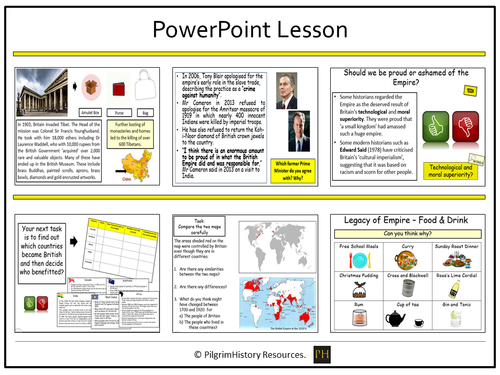


The British Empire
This lesson aims to find out whether we should be proud or ashamed of gaining an Empire and how the indigenous peoples we conquered ‘benefitted’ under British rule.
This lesson will best be delivered over 2 lessons . The opening slides give some context to the debate and define what an Empire is and which countries Britain owned by 1900.
Through video and source analysis, the students have to explain their choice of being proud or ashamed or both and as the lesson progresses justify whether they are sticking to their decisions.
Analysis focuses on Victorian propaganda, the recent views of British Prime Ministers as well as how museums refuse to engage about how they have obtained their imperial artefacts.
The second part of the lesson examines a number of countries acquired by Britain and focuses on the ‘benefits of Empire’. Students then make their final decisions at the end before drawing conclusions on the legacy of the British Empire.
A homework task is to design an Empire plate (photographic examples given) to celebrate Empire day from 1902.
The lesson comes with suggested teaching and learning strategies, differentiated materials and is linked to the latest historical interpretations, video clips and debate.
The lesson is enquiry based with a key question posed at the start of the lesson and revisited at the end to show the progress of learning.
The lesson is fully adaptable in PowerPoint format and can be changed to suit.
Something went wrong, please try again later.
This resource hasn't been reviewed yet
To ensure quality for our reviews, only customers who have purchased this resource can review it
Report this resourceto let us know if it violates our terms and conditions.
Our customer service team will review your report and will be in touch.